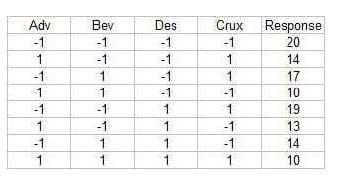CLSSYB Online Practice Questions and Answers
What conclusion is most correct about the Experimental Design shown here with the response in the far right column?

A. No factor has enough statistical confidence greater than 95% to have an impact on the response rate
B. Constant, Adv and Bev are the only factors statistically affecting the response rate with 95% confidence or more
C. If the Adv is increased from the low level to the high level, the response rate increases
D. The response level is statistically concluded to only need the Adv and Bev factors set at the low level to get the largest response rate
Relative to a Design of Experiments the term _____ refers to variables being a linear combination of each other.
A. Mirror Image
B. Directly Parallel
C. Collinear
D. None of the above
Contingency Tables are used to perform which of these functions?
A. Illustrate one-tail proportions
B. Analyze the "what if" scenario
C. Contrast the Outliers under the tail
D. Compare more than two sample proportions with each other
What percentage of data is included in +/- 1.5 Sigma?
A. 43.32 %
B. 86.64 %
C. 68.24 %
D. 0 %
For Six Sigma, the period of evolution started from: A. 1986 – 1992
B. 1986 – 1992
C. 1994 – 1996
D. 1979 - 1986
Run charts can be understood by the following:
A. Anderson darling test
B. 80-20 rule
C. Clusters, Mixtures, Oscillations and trends
D. excel spreadsheet
Benefits and working conditions would be primarily the concern of which of the following?
A. Voice of the Customer
B. Voice of the Employee
C. Voice of the Business
D. Voice of the Process
The "Method" category of Root Causes on a Fishbone Diagram is primarily used to generate ideas as to the possible causes for defects by the ____________.
A. Inventory management
B. Effects of the environment
C. Way work is done
D. Parts or forms used
A Belt gathered the following defect data for a polyurethane production line and wanted to assemble it into a Pareto Chart. The correct order from left to right in the chart would be:
Data: Trimming 37 Forming 61 Packaging 29 Sealing 5
A. Trimming, Packaging, Sealing, Forming
B. Packaging, Trimming, Sealing, Forming
C. Sealing, Forming, Trimming, Packaging
D. Forming, Sealing, Trimming, Packaging
Lean Principles defines for us seven specific areas where ________ typically exists in our processes.
A. Waste
B. Excess inventory
C. Variation
D. Data error